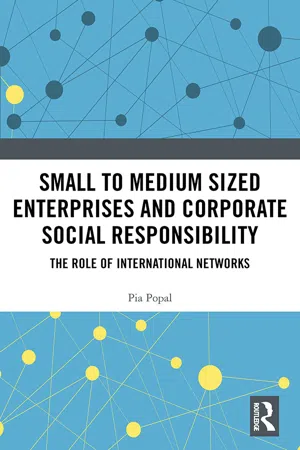Quantitative characteristics are a crucial starting point for classifying smaller firms, yet the number of employees does not reveal much about if or how they differ from large firms, except that they are smaller in size. It does not convey much about the way they practise business per se, or how, for instance, their structure might influence the way in which they interpret sustainable action. It can therefore be argued that a mere quantitative description of SME characteristics does not suffice to grasp the characteristic distinctiveness of smaller firms. In addition to a numerical categorisation, which is helpful as an initial distinction, the delineation of further characteristics is, in my view, essential in order to capture the complexity of SME specifics.
General terms
Apart from quantitative aspects, smaller companies strongly define their activities along the lines of different aspects such as small and informal organisational structures, an innovative understanding of new business opportunities, as well as a flexible attitude when facing new challenges. Some of the key features attributed to smaller firms will therefore be outlined as follows.5
Flexibility was an early keyword for SME behaviour (Dyson 1990, p. 21). The willingness to adjust is, among others, a survival mechanism. SME are ‘very adaptive, swiftly adjusting their trading capacities according to changing market opportunities’ (Goffee and Scase 1995, p. 18). In other words, the small size enables private business actors to respond more quickly to changing circumstances. These flexible structures also point to another important SME feature.
Innovation: SME are concurrently capable of taking ‘advantage of new niche markets for products and services’ (Jenkins 2009, p. 23) by innovative means. In that sense, SME ‘serve as “growth labs” for innovation and risk-orientated product development’ (Morsing and Perrini 2009, p. 2). SME tend to invest, in relative terms, more than larger firms in Research and Development (R&D), and the rate at which innovations are implemented is correspondingly faster (Hull 1983, pp. 158–159).6 In 2013, for instance, SME invested €9 billion in R&D (IfM 2015).
Resource limitations: Yet, technical enhancements in the broader context are limited to available (and, in SME, often scarce) financial resources (Gaskill et al. 1993; Raymond 2001; Spence 1999, 2007). They have therefore been repeatedly characterised as being short of means (Jenkins 2004; McWilliams and Siegel 2001; Tilley 2000). In fact, smaller businesses tend to face a variety of crucial resource limitations, such as having less financial investment and less time than larger corporations. Many SME subsequently lack time for anything other than survival (Enderle 2004; Spence 1999, p. 165; Tilley 2000, p. 5).7 These chronic conditions of shortage that frequently accompany daily business operations in SME may conversely function as an amplifier in initiating innovative processes. This aspect draws, for instance, upon the understanding that necessity is the mother of invention.
Less hierarchy: SME also have different organisational structures in comparison to large companies. They possess less hierarchical complexity (MacMillan 1975). Owner-managers exert a strong influence over these structures and introduce their personal values intuitively into business practice (Murillo and Lozano 2006; Russo and Tencati 2009; Sen and Cowley 2014; Spence and Rutherford 2004). Thus, personality characteristics can deeply affect the way in which information is facilitated within a company (Murphy 1996). Knowledge is usually gained in informal ways and habitually builds on personal experience (Fassin 2008; Perrini et al. 2007). Communication procedures are only rudimentary and not strictly established (Preuss and Perschke 2010; Spence 1999). Employees are often responsible for several business tasks simultaneously (Murillo and Lozano 2006; Perrini et al. 2007; Spence 1999). Because of this multi-functionality, time and task pressures are likely to be great (Spence 1999). Consequently, awareness of issues that do not concern the daily routines of the business may be low (Tilley 2000).
Personal relationships: To a large degree, these firms are family-owned (Spence 2007) and are also managed by the owner (Preuss and Perschke 2010; Russo and Tencati 2009). Personal relationships are a common denominator in SME. Family involvement on the management level can enhance employees’ trust in the companies’ objectives and agenda. More particularly, the involvement of the owners demonstrates their personal commitment, which may positively affect employees’ willingness to identify with and trust in the objective of the firm (Spence 1999, p. 165). Trust in relationships is also at the basis of long-term commitment to small firms. In SME, apprentices frequently stay with the company where they commenced their apprenticeship. More generally, employee loyalty and employment duration are greater in smaller firms than in their larger counterparts. Accordingly, the personal character of relational structures can be relevant to customers and other stakeholders. Relationships with customers have usually been developed over long periods of time by the same token. These examples demonstrate a high degree of investment in (local) social capital by small firms. In sum,
[T]he enhanced possibility of personal contact between the owner-manager, employees, suppliers, customers and even competitors may enable the building of trust relationships which can act as a bedrock of open and honest dialogue in a way which is impracticable in the larger f...
